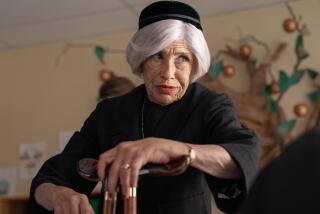The Envelope: How ‘Room’ balanced a child’s love for his space with the ugly reality of captivity
When director Lenny Abrahamson set out to adapt Emma Donoghue’s bestselling novel “Room,” he didn’t realize the Herculean effort this inventive story would demand of the cast and crew.
“Room” explores the poignancy of childhood through the view of a 5-year-old boy who is born and raised in the 10-by-10-foot garden shed where he has been held captive with his mother. As in the 2010 novel, the film makes the shed, called simply Room, as much a character as Ma, played by Brie Larson, the boy Jack, played by Jacob Tremblay, and kidnapper Old Nick, played by Sean Bridgers. So are Wardrobe, Bed, Rug, Door and Skylight.
But rather than resort to escapist animation or magical realism, Abrahamson wanted his set to conjure the banal horror of captivity as well as the limitless bounds of a child’s imagination. He also wanted to remove as many obstacles as possible for Larson and child actor Tremblay, then 8, to allow them to believably portray life in such a cramped space.
See more of Entertainment’s top stories on Facebook >>
“If I make this place the way it would really be,” Abrahamson wondered, “how do I stop that experience from overwhelming an audience and preventing them from experiencing something of the magic of this child’s take on this place?”
Production designer Ethan Tobman had an idea. Or rather, he conjured an illusion. He designed Room as “an inverted Rubik’s Cube.” This preserved the integrity of Room as an enclosed, 10-by-10 space, limiting the point of view of the actors while creating discreet windows for Abrahamson’s cameras to look in.
“It’s built as a series of squares,” said Tobman. “Nothing in that room from the tile on the floor to the tiles on the ceiling to the tiles on the wall, nothing’s larger than 1-by-1-foot. And each [tile] can be removed. So if you want to put two cameras in this room, you pick out a square, remove it and essentially peer in. And the crew is outside.”
So when Jacob appears lost in his imagination as he plays with his homemade egg carton snake or relaxed as he shares a quiet moment with Larson, he truly was. In fact, the two actors often spent hours together in the room making crafts and playing while the entire 60- to 100-member film crew was outside peeking in. Still, the scenes were intense.
“There was a moment every day where someone on the crew cried,” said Tobman. “Seeing that child be subjected to this reality and watching Jake’s and Brie’s extraordinary performances bring it to life, was overwhelming.”
Tobman’s design drew on the real-life stories that inspired Donoghue. These included Austrian Elisabeth Fritzl and her subsequent children, who were held in a basement for 24 years by her father, and Ariel Castro’s three female captives and one child, held for 11 years in a Cleveland home.
“We started looking at Holocaust camps, at Syrian prisoner of war shtetls, at immigration holding tanks in foreign countries,” Tobman said. “We looked at Guantanamo. We looked at prisons [and] the dwellings of Hong Kong and Tokyo’s exploited workers.”
He furnished Room just as an uneducated, unemployed kidnapper would have. Cheap cork tiles were used as soundproofing. The 1970s bathtub was found at a yard sale. Side tables were from Ikea. A 60-year-old bed frame was picked up from a church basement and a 1950s flesh-toned sink from a salvage yard.
“Everything has texture and warmth and detail,” said Tobman. “Everything’s layered and has personality and is loved. It’s uterine. There isn’t a square inch of that space that isn’t shrouded in intimacy despite the brutality.”
More to Read
From the Oscars to the Emmys.
Get the Envelope newsletter for exclusive awards season coverage, behind-the-scenes stories from the Envelope podcast and columnist Glenn Whipp’s must-read analysis.
You may occasionally receive promotional content from the Los Angeles Times.










